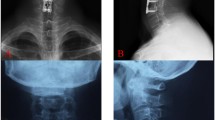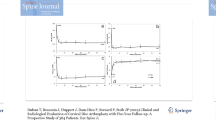Abstract
Purpose
To determine the efficacy of total disc replacement (TDR) for the treatment of cervical spondylosis associated with atypical symptoms.
Methods
In this retrospective study, patients with myelopathy and/or radiculopathy related to cervical spondylosis that were treated with TDR were contacted by phone. Atypical symptoms involved in the questionnaire included dizziness, headache, nausea, vomiting, blurred vision, tinnitus, palpitations, hypomnesia, and abdominal discomfort. The severity of each atypical symptom was evaluated separately based on an numerical rating scale. The radiographs and charts before and after the surgery were reviewed. Paired samples t tests were used to compare the severity of the symptoms before and after surgery.
Results
Between 2003 and 2010, 73 of 133 patients diagnosed with cervical spondylotic myelopathy and/or radiculopathy treated by TDR experienced atypical symptoms before surgery. The mean follow-up was 34.6 months. There were 47 males and 26 females (mean age 48.9 years). Of the 73 patients, 41 were diagnosed with myelopathy; 13 with radiculopathy; and 19 with mixed-type spondylosis. The incidence of each symptom before surgery was dizziness (46.6 %), tinnitus (41.1 %), facial flushing and sweating (41.1 %), palpitations (39.7 %), headache (35.6 %), hypomnesia (30.1 %), nausea and vomiting (20.5 %), blurred vision (20.5 %), and gastroenterologic discomfort (5.5 %). The severity of the following symptoms improved after surgery: dizziness (p = 0.000, α = 0.05), headache (p = 0.000, α = 0.05), nausea and vomiting (p = 0.000, α = 0.05), blurred vision (p = 0.004, α = 0.05), tinnitus (p = 0.000, α = 0.05), palpitations (p = 0.000, α = 0.05), hypomnesia (p = 0.010, α = 0.05), and other symptoms (p = 0.030, α = 0.05). The gastroenterologic discomfort did not improve (p = 0.731, α = 0.05).
Conclusions
TDR may have a positive effect on atypical symptoms associated with cervical spondylotic myelopathy and/or radiculopathy.
Similar content being viewed by others
Avoid common mistakes on your manuscript.
Introduction
Patients complaining of symptoms of dizziness, headache, tinnitus, and blurred vision, are quite common in spinal clinics. Cervical spondylotic changes are present on imaging studies, and problems have been ruled out by the neurologist, otolaryngologist, and other relevant specialists. Diagnosis and treatment of these patients are controversial because it is difficult to determine whether the symptoms are actually caused by the degenerative cervical changes. Nonoperative therapies, such as immobilization, non-steroidal anti-inflammatory drugs (NSAIDS), and rest, are prescribed to most of the patients. Surgery is rarely indicated for patients presenting only with these atypical symptoms despite obvious degenerative changes on imaging studies. Surgery is indicated for patients with spondylotic myelopathy or radiculopathy who have failed conservative therapy. The effects of surgery on myelopathy and radiculopathy are widely reported in the literature; however, the effect of surgery on the atypical symptoms remains poorly defined [4]. In this study, we report the surgical outcomes of the atypical symptoms of patients who were treated by total disc replacement (TDR) for spondylotic myelopathy and/or radiculopathy.
Materials and methods
A total of 133 patients with cervical spondylotic myelopathy and/or radiculopathy treated by TDR from 2003 to 2010 were followed up. Of these patients, 73 exhibited various patterns of atypical symptoms, such as dizziness, tinnitus, headache, and blurred vision, in addition to symptoms of myelopathy and/or radiculopathy. These 73 patients were included in this study. The radiographs and medical charts before and after the surgery were retrospectively reviewed.
There were 47 males and 26 females with an average age of 48.9 years (range 30–71 year). Forty-one patients were diagnosed with myelopathy, 13 patients with radiculopathy, and 19 patients with radiculomyelopathy. The mean follow-up was 34.6 months (range 11–92 months).
The indications to perform cervical TDR in our institute included (1) myelopathy or refractory radiculopathy due to degenerative disc disease confirmed by magnetic resonance imaging (MRI) and/or computed tomography (CT) myelogram; (2) no instability on lateral flexion–extension view; (3) motion preserved at the index level(s); (4) no obvious facet joint arthrosis; and (5) no congenital bony canal stenosis.
TDR was performed through a standard Smith-Robinson approach according to the operation manual. After decompression (posterior longitudinal ligament routinely removed), the artificial disc was inserted. The BryanTM disc (Medtronic, Minneapolis, Minnesota, USA) was used in 72 patients, and the DiscoverTM disc (Johnson&Johnson, NJ, USA) was used in one patient. Sixty-two patients had single level cervical TDR (five cases of C3/4; 12 cases of C4/5; 35 cases of C5/6; 10 cases of C6/7). Ten patients had double level cervical TDR (one case of C3/4 and C6/7; five cases of C4/5 and C5/6; four cases of C5/6 and 6/7). One patient underwent three-level cervical TDR (C3/4, C4/5, and C5/6).
A questionnaire including the common atypical symptoms was designed. A sample of atypical symptoms evaluation form is shown in Table 1. The average severity of each symptom was scored with a 10 point numerical rating scale. The proportion of each symptom was also recorded if the patients had more than one symptom. Patients were asked to fill in the questionnaire before surgery and at the last follow-up. The severity of the atypical symptoms before and after surgery was compared. Statistical analysis was done by paired-samples t test.
Results
The incidence of each symptom in this series before surgery is shown in Fig. 1. The severity score of symptoms before surgery and at the last follow-up is shown in Table 2. The improvement rate of each symptom is shown in Fig. 2 with dizziness, headache, palpitation, nausea and vomiting improved more than 50 %. The improvement rate was graded into five groups: <0 (deterioration), 0 (no change), 0–25, 25–50, 50–75, 75–100 %. The distribution of improvement rate of each symptom was demonstrated in Fig. 3.
Discussion
Patients presenting with symptoms of dizziness, headache, blurred vision, and palpitations are quite common in spinal clinics. Cervical disc degenerative changes on imaging studies are usually the only abnormality found after consulting relevant specialists, such as neurologists, otolaryngologists, cardiologists, and other relevant specialists. Are these symptoms really related to the cervical spine? If they are, then where is the pathology? Thus far, no convincing pathologic mechanism has been discovered, and the diagnosis and treatment of this group of patients are still controversial.
Cervical dizziness [1, 8], headache [11], and angina [5] have been reported in the literature. Actually, patients usually present with a constellation of symptoms, not just one single symptom. Since these symptoms are not typically associated with cervical spondylosis, here, we use “Atypical” to include them all. Currently, there is no widely accepted method for evaluating patients with atypical symptoms due to the following reasons: (1) symptoms are very subjective; (2) patients may present with different combinations of symptoms; (3) the frequency of episodes varies from patient to patient; and, (4) the proportion and the severity of each symptom may vary in different episodes.
The mechanism by which the atypical symptoms are induced is unclear. Mechanical compression of the vertebral artery [9] by an osteophyte, vertebrobasilar ischemia caused by cervical sympathetic nerve compression from chronic cervical arthritis [3, 6], instability of the cervical spine [7, 10], and whiplash injury [2] have all been reported to be associated with the atypical symptoms.
In this series of patients, neither direct compression on the vertebral artery nor cervical instability was present. The fact that the atypical symptoms improved significantly after surgery may indicate a surgical effect. During the TDR surgery, the disc and the posterior longitudinal ligament at the same level were removed to achieve complete decompression of the nerve root and/or spinal cord, and segmental motion was preserved. So, the positive effect might be due to the removal of the disc and the posterior longitudinal ligament and/or to the decompression of the neural structures (nerve root and/or spinal cord). But we still can not draw a conclusion on the pathogenesis of these atypical symptoms based on this study. We tried to determine the risk factors for the atypical symptoms, including patient-related and imaging-related factors, such as the age, sex, structures compressed (nerve root, cord or both), levels involved, etc., but have not found any association between these factors and the symptoms yet.
For cervical spondylotic patients complaining only of atypical symptoms, there is still not a specific diagnostic test to determine the pathoanatomic etiology responsible for the atypical symptoms, thus, TDR is rarely indicated. Though satisfying effect on the atypical symptoms was achieved by TDR in this study, it seems like an extra benefit. Since there was not a controlled group in this study, it is no powerful design to answer the question on the efficacy of c-TDR for treatment of “atypical” symptoms. Cervical TDR should not be or more exactly should only be very cautiously proposed to patients with “atypical” symptoms. The encouraging effect on the atypical symptoms after TDR may imply that the degenerative cervical spine should be the target of diagnostic tests in future research.
In conclusion, TDR may have a positive effect on atypical symptoms associated with cervical spondylotic myelopathy and/or radiculopathy. Cervical disc degeneration and the compression of the neural structures might be the cause of the atypical symptoms.
References
Brandt T, Bronstein AM (2001) Cervical dizziness. J Neurol Neurosurg Psychiatry 71(1):8–12
Endo K, Ichimaru K et al (2006) Cervical dizziness and dizziness after whiplash injury. Eur Spine J 15(6):886–890
Foster CA, Jabbour P (2007) Barre-Lieou syndrome and the problem of the obsolete eponym. J Laryngol Otol 121(7):680–683
Hong L, Kawaguchi Y (2011) Anterior cervical discectomy and fusion to treat cervical spondylosis with sympathetic symptoms. J Spinal Disord Tech 24(1):11–14
Ito Y, Tanaka N et al (2004) Cervical angina caused by atlantoaxial instability. J Spinal Disord Tech 17(5):462–465
Pearce JM (2004) Barre-Lieou “syndrome”. J Neurol Neurosurg Psychiatry 75(2):319
Qian J, Tian Y et al (2009) Dynamic radiographic analysis of sympathetic cervical spondylosis instability. Chin Med Sci J 24(1):46–49
Ryan GM, Cope S (1955) Cervical dizziness. Lancet 269(6905):1355–1358
Strek P, Reron E et al (1998) A possible correlation between vertebral artery insufficiency and degenerative changes in the cervical spine. Eur Arch Otorhinolaryngo 255(9):437–440
Vinchon M, Assaker R et al (1995) Vertebrobasilar insufficiency resulting from traumatic atlantoaxial instability: case report. Neurosurgery 36(4):839–841
Wight S, Osborne N et al (1999) Incidence of ponticulus posterior of the atlas in migraine and cervicogenic headache. J Manipulative Physiol Ther 22(1):15–20
Conflict of interest
None.
Author information
Authors and Affiliations
Corresponding author
Rights and permissions
About this article
Cite this article
Sun, YQ., Zheng, S., Yu, J. et al. Effect of total disc replacement on atypical symptoms associated with cervical spondylosis. Eur Spine J 22, 1553–1557 (2013). https://doi.org/10.1007/s00586-013-2785-6
Received:
Revised:
Accepted:
Published:
Issue Date:
DOI: https://doi.org/10.1007/s00586-013-2785-6







